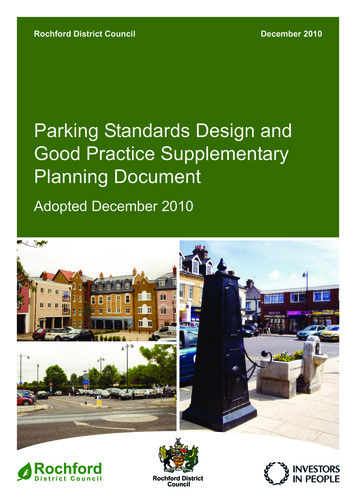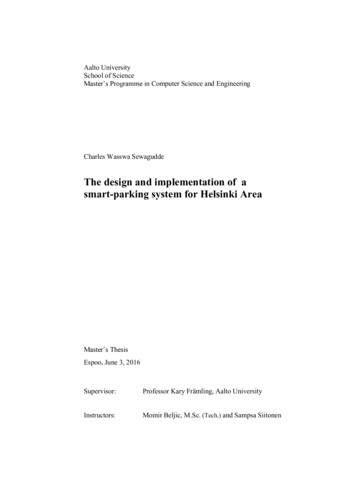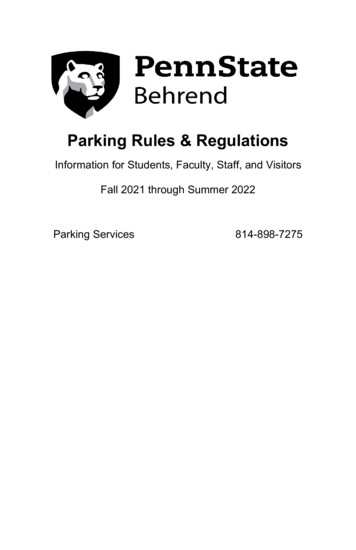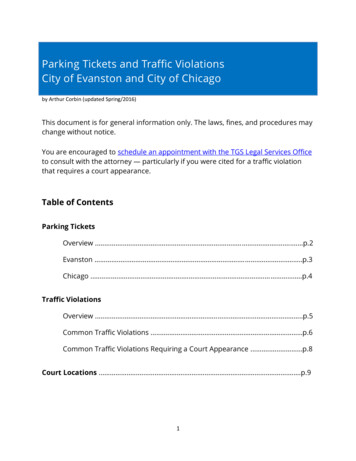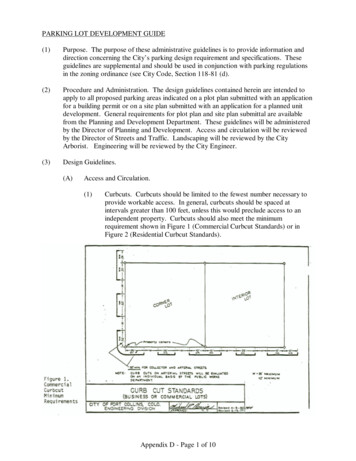
Transcription
Parking Lot Design5-1Chapter 5Parking Lot DesignGENERAL CONSIDERATIONSThe parking lot is the first - and the last part of a building complex to be viewed by theuser. It is the gateway through which allcustomers, visitors, and employees pass. Thisfirst impression is very important to theoverall feeling and atmosphere conveyed tothe user.Developers want their new facilities to beattractive, well designed, and functional.Though many hours are spent on producingaesthetically pleasing building designs, thesame design consideration for the parking areais often overlooked. Pavements in parkingareas that are initially under-designed canexperience excessive maintenance problemsand a shortened service life.When properly designed and constructed,parking areas can be an attractive part of thefacility that is also safe, and most important,usable to the maximum degree. In addition,parking areas should be designed for lowmaintenance costs and easy modification forchanges in use patterns.
5-2Parking Lot DesignThe information in this chapter will providea general guide to proper parking area design,construction, and facility layout. Minimumpavement thickness designs are given forvarious size parking lots, heavily-loaded areas,and industrial parking lots. In addition, thischapter gives comparable designs for both fulldepth asphalt pavements and asphalt overuntreated aggregate base.General PlanningIn developing the parking area plan, severalimportant details should be considered. Firstand foremost in the mind of the developer maybe providing the maximum parking capacityin the available space while ensuring convenience and safety.Rules have been developed for optimizingparking area space. Among them are thefollowing:1. Use rectangular areas where possible.2. Make the long sides of the parking areasparallel.3. Design so that parking stalls are locatedalong the lotÕs perimeter.4. Use traffic lanes that serve two rows ofstalls.Table 5-1. Recommended Parking RequirementsLand MultifamilyIf the locality does not have a zoningordinance identifying specific requirements foroff-street parking, the general recommendations in Table 5-1 may be useful.Efficiency1.0/Dwelling1 -2 iversity0.5/StudentRetail4.0/1000 GFAOffice3.3/1000 GFAShopping Center5.5/1000 GLAHotels/Motel1.0/Room0.5/EmployeeSenior High Schools0.2/Student1.0/StaffOther SchoolsGFA, sq. ft. of gross floor areaGLA, sq. ft. of gross leasable area1.0/Classroom
Parking Lot DesignSpecial attention should be given to the flowof traffic in and out of the lot as well as circulating routes inside the lot. Keep entrances faraway from busy street intersections and fromlines of vehicles stopped at a signal or stopsign. Be sure that the entering vehicles canmove into the lot on an internal aisle, therebyavoiding entering congestion caused by involvement with turning vehicles. A pedestriantraffic-flow study is important to provide information about both safety and convenience.5-3spaces for a given area but is the onlyacceptable angle for a herringbone parking lotpattern.The 90¡ parking angle provides the mostparking spaces for a given area. The highdegree of difficulty for entering and leavingthese parking stalls makes this type of parkingmore suited to all-day parking, such asemployee parking. This angle is generally notpreferred for Òin and outÓ lots such as those offast food restaurants and banks.Figure 5-1. Parking lot anglesParking AngleThe most popular angles for parking stallsare 60¡, 45¡, and 90¡ . The most common anglefor parking is the 60¡ angle because of the easeof operation it provides. This angle permitsreasonable traffic lane widths and eases entryand exit of the parking stall.Where lot size restricts the dimensionsavailable for aisles and stalls, a 45¡ angle maybe used. The smaller change of directionrequired to enter and back-out of the stallspace permits use of narrower aisles. The 45¡angle reduces the total number of parkingParking Space DimensionsTypical parking stall dimensions vary withthe angle at which the stall is arranged inrelation to the aisle. Stall widths (measuredperpendicular to the vehicle when parked)range from 8-1/2 to 9-1/2 feet. The minimumwidth for public use parking spaces is 9 feet by19 feet. Recommended stall dimensions forcompacts and similar-sized vehicles are 7-1/2feet by 15 feet. If a number of such spaces areto be provided, they should be groupedtogether in a prime area to promote their use.Stall widths for parking lots where shoppersgenerally have large packages, such assupermarkets and other similar parkingfacilities, should be 9-1/2 feet or even 10 feetwide.
5-4Parking Lot DesignFigure 5-2.Table 5-2. Parking layout dimensions (ft) for9 ft stalls at various angles.STALL LAYOUT ELEMENTSDimensionStall width parallel to aisleStall length of lineStall depth to wallAisle width between stall linesStall depth, interlockModule, wall to interlockModule, interlockingModule, interlock to curb faceBumper overhang (typical)OffsetSetbackCross aisle, one-wayCross aisle, two-wayOndiagram45 60 78.314.024.075 90 ing Lot MarkingsMarkings are a very important element of agood parking lot. The parking area should beclearly marked to designate parking spacesand to direct traffic flow. As specified in theManual on Uniform Traffic Control Devices(MUTCD), parking on public streets should bemarked out by using white traffic paint, exceptfor dangerous areas, which should be markedin yellow.However, yellow lines are commonly usedin off-street parking lots. All pavement stripingshould be 4 inches in width.New asphalt surfaces can be marked witheither traffic paint or cold-applied markingtape. For best results with paint application,allow the Asphalt Concrete to cure for severaldays.Construction PracticesDrainage ProvisionsDrainage problems are frequently a majorcause of parking area pavement failures. It iscritical to keep water away from the subgradesoil. If the subgrade becomes saturated, it willlose strength and stability, making theoverlying pavement structure susceptible tobreakup under imposed loads.Drainage provisions must be carefullydesigned and should be installed early in theconstruction process. Parking area surfacesshould have a minimum slope of 2 percent or1/4 inch per foot. They should be constructedso water does not accumulate at the pavementedge. Areas of high natural permeability mayrequire an underdrain system to carry wateraway from the pavement substructure. Anysoft or spongy area encountered duringconstruction should be immediately evaluatedfor underdrain installation or for removal andreplacement with suitable materials.
Parking Lot DesignThe use of Asphalt Concrete base (comparedto use of untreated aggregate base) will greatlyreduce the potential for problems related towater strength and stability.Subgrade PreparationsAll underground utilities should be protected or relocated before grading. All topsoilshould be removed. Low-quality soil may beimproved by adding granular materials, lime,asphalt, or other mixtures. Laboratory tests arerecommended to evaluate the load-supportingcharacteristics of the subgrade soil. However,designs are frequently selected after carefulfield evaluations based on experience andknowledge of local soil conditions.The area to be paved should have all rock,debris, and vegetation removed. The areashould be treated with a soil sterilant to inhibitfuture flora growth. Grading and compaction5-5of the area should be completed so as toeliminate yielding or pumping of the soil.The subgrade should be compacted to auniform density of 95 percent of the maximumdensity. This should be determined inaccordance with Standard Proctor density(Test Method 103). The compaction requirement may substitute a specified number ofdiskings and roller coverages of each lift.When finished, the graded subgrade shouldnot deviate from the required grade and crosssection by more than 1/2 inch in 10 feet.Prime CoatAn application of a low-viscosity liquidasphalt may be required over untreatedaggregate base before placing the AsphaltConcrete surface course. A prime coat and itsbenefits differ with each application, and itsuse often can be eliminated. Discussrequirements with the paving contractor.
5-6Parking Lot DesignAsphalt Base ConstructionThe asphalt base course material should beplaced directly on the prepared subgrade inone or more lifts. It should be spread andcompacted to the thickness indicated on theplans. Compaction of this asphalt base is oneof the most important construction operationscontributing to the proper performance of thecompleted pavement. This is why it is soimportant to have a properly prepared andunyielding subgrade against which tocompact. The asphalt base material shouldmeet the specifications for the mix typespecified.Untreated Aggregate Base ConstructionThe untreated aggregate base course shouldconsist of one or more layers placed directly onthe prepared subgrade. It should be spreadand compacted to the uniform thickness anddensity as required on the plans. The minimumthickness of untreated aggregate is 4 inches. Theaggregate material should be of a type approved and suitable for this kind of application.It should be noted that an untreatedaggregate base is sensitive to water in thesubgrade. The pavement failures associatedwith water in the subgrade are accelerated ifan untreated base allows water to enter thepavement structure.Tack CoatBefore placing successive pavement layers,the previous course should be cleaned and atack coat of diluted emulsified asphalt shouldbe applied if needed. The tack coat may beeliminated if the previous course is freshlyplaced and thoroughly clean.Asphalt Concrete Surface CourseMaterial for the surface course should be anAsphalt Concrete mix placed in one or morelifts to the true lines and grade as shown on theplans. The plant mix material should conformto specifications for Asphalt Concrete.The asphalt surface should not vary fromestablished grade by more than 1/4 inch in 10feet when measured in any direction. Anyirregularities in the surface of the pavementcourse should be corrected directly behind thepaver. As soon as the material can becompacted without displacement, rolling andcompaction should start and should continueuntil the surface is thoroughly compacted andall roller marks disappear.
Parking Lot DesignTHICKNESS DESIGN FORPARKING LOTSDesign thicknesses given in this section areminimum values calculated on the volume andtype of traffic that will use the facility and onthe load-supporting capability of theunderlying soils. For additional soil classinformation, refer to Chapter 3.Special truck lanes are sometimes requiredto expedite traffic to loading areas, trashdumpster sites, and equipment areas. Designthicknesses for these lanes or pavement areasshould be increased. Drainage problems arealso a major cause of pavement failures. Theirsignificance warrants a special section ondrainage that should be reviewed beforeselecting a pavement design either from thisguide or from any other source.Design ProcedureTables 5-3 through 5-6 can be used directly toselect design thicknesses for a number ofdesign input factors. To use the tables,appropriate traffic and subgrade classes mustbe selected as follows.Design StepsThe following steps can be used todetermine a pavement thickness.1. Using the number of parking spaces tobe marked, select the traffic class (lessthan 50 spaces, 50 to 500, more than 500,or industrial) to be used. Determine ifany areas will receive heavy truck traffic.5-72. Using soil data from the project, select asubgrade class (good, moderate, or poor)from Chapter 3. If no soil information isknown, use the poor classification for thesubgrade. (If the CBR value for the soillies between the values given, use thelower classification. )3. Using the selected traffic class andsubgrade class, select a design thicknessfrom Tables 5-3, 5-4, or 5-6. Use Table 5-5to design heavily-loaded areas.Design Example A new department store wishes to placea 350-car parking lot in front. A truckloading zone and dumpster site will beplaced in back. From Chapter 3, trafficclass II is selected. No soil data are known, so the engineerselects the poor soil classification. The total full-depth asphalt designthickness selected from Table 5-4 for theparking lot is 6-1/2 inches; the basecourse is 5 inches, and the surface courseis 1-1/2 inch. The total full-depth asphaltdesign thickness selected from Table 5-5for the truck loading zone andapproaches is 8 inches; the base course is6 inches and the surface course is 2inches.
5-8Parking Lot DesignPavement Thickness TablesThe pavement thickness for parking lotsshould be in accordance with the followingtables:Table 5-3. Thickness Chart: Parking Lots with Less Than 50 SpacesA. For Asphalt Concrete Base PavementsThickness in InchesAsphalt ConcreteDesign Criteria*Traffic Class(Spaces)I( 50 4.0Moderate63.51.04.5Poor34.01.05.0B. For Untreated Aggregate Base PavementsDesign Criteria*Traffic Class(Spaces)I( 50 spaces)Thickness in InchesSubgradeClassCBRUntreated AsphaltAggregate 3.07.0Poor36.03.09.0*See chapter 3 for traffic and soil class details
Parking Lot Design5-9Table 5-4. Thickness Chart: Parking Lots with More Than 50 SpacesA. For Asphalt Concrete Base PavementsThickness in InchesHot Mix AsphaltDesign Criteria*Traffic Class(Spaces)II(50-500 spaces)III(500 & Above oderate64.51.56.0Poor35.51.57.0B. For Untreated Aggregate Base PavementsDesign Criteria*Traffic Class(Spaces)II(50-500 spaces)III(500 & Above spaces)Thickness in InchesSubgradeClassCBRUntreated AsphaltAggregate 11.5Poor38.0.4.012.0*See chapter 3 for traffic and soil class details
5-10 Parking Lot DesignHeavily-Loaded AreasThe pavement for entrances, frontage roads,trash dumpster sites, and delivery truckparking, as well as the approach areas to thesespaces, must be increased in thickness toprevent pavement failure caused by the weightand dynamic loading. These areas should beconstructed with full-depth asphalt in athickness that will support this special type ofpavement loading. Failure to provide thisstrengthening can result in severe pavementfailure. The pavement thickness for these areasshould be in accordance with the followingtable:Table 5.5. Thickness Chart: Heavily-Loaded Areas in Parking LotsThickness in InchesAsphalt ConcreteDesign Criteria*Traffic 2.06.0(Up to 20 heavyModerate65.02.07.0trucks per day)Poor36.02.08.0*See chapter 3 for traffic and soil class detailsNote: Untreated aggregate base courses are not recommended for industrial parking lots or forparking areas for heavy trucks.Industrial Parking LotsIndustrial parking lots and those designedprimarily for trucks require a thicker designthan the other lots described in this chapter.Because of heavy loads associated with trucks,it is not recommended that untreated aggregatebase courses be used. The pavement thicknessfor truck lots should be in accordance with thefollowing table:Table 5.6. Thickness Chart: Heavily-Loaded Areas in Parking LotsThickness in InchesAsphalt ConcreteDesign Criteria*Traffic Class(ADTIV(20 to 200 trucksper Moderate66.52.08.5Poor36.53.09.5*See chapter 3 for traffic and soil class details
Parking Lot Design 5-11PLANNED STAGE CONSTRUCTIONASPHALT CONCRETE CURBPlanned stage construction is a means ofproviding fully adequate pavements with theeffective use of funds, materials, and energy.As defined, it is the construction of an AsphaltConcrete parking lot or roadway in two ormore stages, separated by a predeterminedinterval of time. In many situations, buildingpavements by stages makes good economicalsense. It is a technique long used by city andhighway engineers.Asphalt curbs have become increasinglypopular as accessories to paving because theyare: (1) economical and easy to construct; (2)can be built much faster than other types; (3)are not affected by ice- and snow-meltingchemicals; and (4) can be laid on an existingpavement using a slip form paver.Stage Construction is not maintenance. It isthe placement of a minimum depth ofpavement during initial construction, and afinal surface course placed at a planned futuredate. Asphalt Concrete lends itself to this kindof construction.Many parking facilities have some form ofcurbing around the perimeter for bothfunctional and aesthetic reasons. The curbscontrol drainage, delineate the pavement edge,prevent vehicular encroachment on adjacentareas, and enhance the parking lot.As an example, the owner of a newdepartment store with a 350-car parking lot,for financial reasons, decides to stage constructthe 6-1/2Ó full-depth asphalt parking lot. Stage1 is constructed at the time the store is built. Atotal depth of 5Ó of asphalt concrete is placed.Stage 2, consisting of the final surface course of1-1/2Ó, will be placed at a set time in thefuture. The truck loading zone and dumpstersite are paved the full depth during initialconstruction.Stage construction has the advantage ofproviding a thoroughly adequate, all-weatherpavement for the initial development of anarea. Any damage to the Stage 1 pavementcaused by traffic, settlements, or utility tearupscan be repaired prior to placement of the finalsurface. With a proper asphalt tack coat, whereneeded, the Stage 2 pavement bonds to the oldsurface and becomes an integral part of theentire pavement structure.Curb MixtureThe method of mixing the Asphalt Concreteand the composition of the mixture mustconform with IDOT Specification 2303, 2304,or an approved commercial mix. The bitumencontent should be modified as necessary toproduce a suitable mixture for AsphaltConcrete curb construction. Curb mixes thatare proportioned using the mixture sizes of3/8- or 1/2-inch have proven to be mostsatisfactory and are recommended for curbconstruction in Iowa.
5-12 Parking Lot DesignThe addition of 10 to 25 pounds ofpowdered asphalt per ton of mix will producean exceptionally tough and durable curb. Theasphalt cement used in the mix should bereduced on a pound-for-pound basis whenpowdered asphalt is added to the mixture.The temperature of the mixture at the time ofmixing and laying should range from 250¡ Fto a maximum of 300¡ F.Curb ConstructionBefore curb construction begins, the placement area must be cleaned thoroughly. A tackcoat must be applied to the pavement surfaceat a maximum rate of 0.10 gallons per squareyard.Figure 5-3.The Asphalt Concrete curb must be laid trueto the specified line, profile, and cross sectionwith an approved self-propelled curb-layingmachine. The mixture must be fed to thehopper of the machine directly from the truckwith a chute or conveyor, or it should beshoveled by hand into the hopper.Asphalt Concrete curbs should be backedwith earth fill or by constructing a double lineof curb and filling the median with compactedasphalt mix.The following illustrates two basic types ofsystems Ð Asphalt Concrete curbs andPortland Cement Concrete curb and gutter.Figure 5-4. Typical curb sections
Parking Lot Design 5-13ASPHALT MAT-PLATFORM FOR BUILDING CONSTRUCTION AND SITE PAVINGSite paving is the recommended first step inmany types of building construction projects.It offers several advantages as a working mator platform before building construction beginsfor shopping centers, schools, manufacturingconcerns, warehouses, and similar facilities.In this technique, an Asphalt Concrete basecourse is constructed on a prepared subgradeover the entire area that will become parkingareas, service roadways, and buildings. Whenbuilding construction is completed, a finalAsphalt Concrete surface course is placed onthe asphalt base.AdvantagesPaving a building site before construction iscompleted has several benefits. These includethe following:1. It ensures constant accessibility andprovides a firm platform upon whichpeople and machines can operate efficiently,speeding construction.2. It provides a dry, mud-free area forconstruction offices, materials storage, andworker parking, eliminating dust controlexpenditures.3. It eliminates the need for costly selectmaterialÑthe asphalt subfloor ensures afloor slab that is dry and waterproof.4. Steel-erection costs can be reduced becausea smooth, unyielding surface results ingreater mobility for cranes and hoists.
5-14 Parking Lot Design5. The engineer can set nails in the asphaltpavement as vertical- and horizontal-controlpoints, effectively avoiding the risk of lossor disturbance of this necessary survey work.6. Excavation for footings and foundationsand trenching for grade beams can beaccomplished without regard for theasphalt base.Construction PracticesSubgrade PreparationAll vegetation (including root systems),rocks, debris, and topsoil should be removedfrom the area to be paved. To prevent futuregrowth, the subgrade should be treated withan approved soil sterilant. Install drainage andutility facilities; backfill and compact. Adjustments in utilities or underground facilities canbe readily accomplished through the asphaltbase should changes occur.The subgrade must be properly shaped tomeet true lines and elevations. It must becompacted to not less than 95 percent ofmaximum laboratory density. The surface ofthe compacted subgrade must not deviate bymore than 3/4 inch from the established grade.A minimum slope of about 2 percent or 1/4inch per foot should be maintained to provideadequate drainage of surface water from thefinished pavement.Areas that show pronounced deflection underconstruction traffic indicate instability in thesubgrade. If reworking and additional rollingdo not correct the situation, the area soil must beremoved, replaced with suitable material, andcompacted. The use of asphalt-treated base orcoarse granular material is recommended.Base-Platform ConstructionAsphalt Concrete Base Material must beplaced on the prepared subgrade. A base of 4inches or less in depth should be placed in onelift. A base of a total thickness of more than 4inches may be placed in two or more lifts withthe bottom lift being a minimum of 3 inches.The material must be spread and compacted tothe required thickness and density as specifiedand in the grades and dimensions shown onthe plans.The surface of the base must not deviatemore than 1/2 inch when measured with a 10foot straight edge.Surface Course ConstructionAfter building construction is essentiallycompleted, and all building materials andoffices have been removed from the previouslypaved base, preparation for placement of thefinal surface course of Asphalt Concrete canbegin. Should building operations or winterweather delay placement of the final surface,the Asphalt Concrete base will adequatelyserve traffic needs during the interim.Preparation for the surface course requiresthorough cleaning and sometimes washing ofthe asphalt base to remove tracked-on dirt andforeign particles. After cleaning, any crackedor broken areas in the base should be removed,replaced with bituminous mix, and thoroughlycompacted. All manholes, valve boxes, andother pavement fixtures should be brought tofinished grade.The hot mix asphalt surface course consistsof one or more layers placed on the previouslyconstructed Asphalt Concrete base course. Thematerial must be spread and compacted to therequired thickness and in the grades anddimensions shown on the plans.The finished surface must not deviate morethan 1/4 inch when measured with a 10-footstraight edge.Tack CoatBefore placing the surface course, the basecourse should be cleaned thoroughly. Ifneeded, a tack coat of diluted emulsifiedasphalt may be applied for bonding.
College/University 0.5/Student Retail 4.0/1000 GFA Office 3.3/1000 GFA Shopping Center 5.5/1000 GLA Hotels/Motel 1.0/Room 0.5/Employee Senior High Schools 0.2/Student 1.0/Staff Other Schools 1.0/Classroom GFA, sq. ft. of gross floor area GLA, sq. ft. of gross leasable area. Parking Lot Design 5-3

